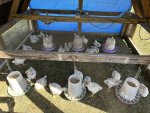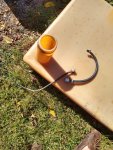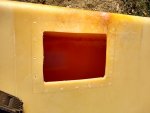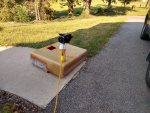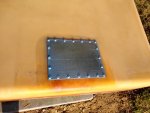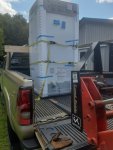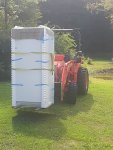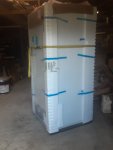Looks great!With favourable dry weather I was able to finish the driveway part out to the road today and after cutting the grass my little G1900 was the first vehicle to drive out and into the driveway
View attachment 162747
If you look closely you can see the green tyre tracksView attachment 162748
What did you do to or on your Kubota today?
- Thread starter gurn
- Start date
Blue2Orange
Active member
Equipment
BX2380 with LA344S & QH05. SB1051. SG0554. BB1248. RB0560, Vassar dirt bucket
Too hot the last couple days. Tuesday 86F/30C. Normal high is ~20C/68F. Good thing I moved gravel on Monday. The transition out of the garage drops ~6-8% for ~10 feet and then abruptly levels. When I drive out with the tractor I need to remember to lift higher than needed normally the bucket or 3pt implement. Or dig out some of the driveway. 2-3 tons of gravel later. No more. Hopefully.
Rain today. Blue sky, fair weather operator. Unless no choice.
Rain today. Blue sky, fair weather operator. Unless no choice.
With favourable dry weather I was able to finish the driveway part out to the road today and after cutting the grass my little G1900 was the first vehicle to drive out and into the driveway
View attachment 162747
If you look closely you can see the green tyre tracksView attachment 162748
Awesome job
Used the RTV to bring the trailer down so I could fill the totes with water. It pulls nice empty. Probably couldn't move it when the totes are full.

ajschnitzelbank
Well-known member
Lifetime Member
Equipment
L4701, BH92, Frost Bite grapple, Logosol M8 mill, Stihl MS661
I have old skidding trails, and some spots are sorta sketchy bringing the tractor through, especially if I’m carrying anything. So I cut down the high spots, dug out some rocks, and filled in the low spots. I don’t really know anything about trail maintenance, so I’m hoping the dirt stays put and the grass/ferns/weeds grow back. We’ll see. Here are some after pics, which don’t look like much, but aren’t we really all here for some tractor pics?



They look good to me. I have been doing that - converting old skid trails to tractor roads - on our place for 25 years. I'm sure you will find that it is really nice to be able to drive the tractor where it couldn't go before.I have old skidding trails, and some spots are sorta sketchy bringing the tractor through, especially if I’m carrying anything. So I cut down the high spots, dug out some rocks, and filled in the low spots. I don’t really know anything about trail maintenance, so I’m hoping the dirt stays put and the grass/ferns/weeds grow back. We’ll see. Here are some after pics, which don’t look like much, but aren’t we really all here for some tractor pics?
View attachment 162816 View attachment 162817 View attachment 162818
gg
johnjk
Well-known member
Lifetime Member
Equipment
B3200 w/loader, Woods RC5 brush hog, 4' box blade, tooth bar, B1700 MMM,
Hooked up the B1700 this morning in the dark and moved the chickens to fresh grass. Week 5 started yesterday. 4 down, 4 to go.
Attachments
-
923.7 KB Views: 70
Did some more tilling yesterday with the L3901DT and BrushHog tiller. It is really dry here, so there was a lot of dust. Need to get some peat to till in and get the grass seed down.

There's always something! Decided to get this eye sore out.


It was a little tricky but I got it out safely. Tried pulling it down first but just wasn't enough traction so I decided to use the pole saw and cut it the rest of the way so it fell and then I was able to pull it out and chop it up. Got some good firewood out of it!!
Came across a lightly used, practically new Sure-Trac 7x20ft 10k trailer with heavy duty ramp/gate for like $4500. Tempted!
It was a little tricky but I got it out safely. Tried pulling it down first but just wasn't enough traction so I decided to use the pole saw and cut it the rest of the way so it fell and then I was able to pull it out and chop it up. Got some good firewood out of it!!
Came across a lightly used, practically new Sure-Trac 7x20ft 10k trailer with heavy duty ramp/gate for like $4500. Tempted!
Sounds like a good deal on the trailer.There's always something! Decided to get this eye sore out.
View attachment 162837
View attachment 162836
It was a little tricky but I got it out safely. Tried pulling it down first but just wasn't enough traction so I decided to use the pole saw and cut it the rest of the way so it fell and then I was able to pull it out and chop it up. Got some good firewood out of it!!
Came across a lightly used, practically new Sure-Trac 7x20ft 10k trailer with heavy duty ramp/gate for like $4500. Tempted!
Watering trees.

The dealer dropped off my GS1572 a couple of days ago. The rear blades didn't show up yet but I may give it a workout tomorrow.

The dealer dropped off my GS1572 a couple of days ago. The rear blades didn't show up yet but I may give it a workout tomorrow.
Last edited:
I have found that 12 gauge game loads will bring limbs like that down.There's always something! Decided to get this eye sore out.
View attachment 162837
View attachment 162836
It was a little tricky but I got it out safely. Tried pulling it down first but just wasn't enough traction so I decided to use the pole saw and cut it the rest of the way so it fell and then I was able to pull it out and chop it up. Got some good firewood out of it!!
Came across a lightly used, practically new Sure-Trac 7x20ft 10k trailer with heavy duty ramp/gate for like $4500. Tempted!
Well, it’s partly a Kubota. The engine is a 1.3L V1305-EBG.
Time to do some needed generator maintenance. First is the diesel. It's a freebie Amida ex-light tower from where I worked. A few years ago I removed all the old junk lighting and did some rewiring. Added frequency, voltage and amperage meters and used it several times since. It has come in handy for welding away from home (the THD is under 5% so it's safe for the welders I have). The only "servicing" I did was check the oil and antifreeze early on because it had been on our maintenance list at work. Then somehow a couple of years passed by.
Wanting to be thorough, the fuel tank had to be dropped and cleaned. This equipment is decades old and it's hard to say what trash may have been dumped in along with the fuel or if its immunizations are up to date. It was topped off last Fall with fresh treated fuel. I did take it to a neighbor’s place about a month ago and ran it for a day to power her sump pumps during a power outage.
Phase 1 was to pump the fuel out. I pumped several gallons into a clean glass gallon container and observed no water or dirt. There may have been 25 gallons or so in the 32 gallon tank that I reclaimed. It went into my storage for now. Since there's a 10 micron waterblock filter on my dispenser I'm not worried. With the tank almost dry, you could see trash in the bottom. The outside of the tank cleaned up quickly with purple cleaner and a little brushing.
On the first “slosh and dump” with about ½ gallon of diesel onto a clean white rag, it looked like someone tossed a small handful of decomposed leaves from the rain gutter. It became apparent that more serious efforts would need to be made.
Even though there is a wealth of info on cleaning fuel tanks, nothing really stood out as a good approach for this one. After much agonizing, the decision was made to cut an access hole to allow scrubbing the inside. Fortunately there was an 1/8” aluminum plate that was left over from an electrical project many years ago that could serve as a cover plate. It already had a hole in each corner, so it was just a matter of drilling another 16 and buying some sealer.
A series of different cleaning methods were employed. After the slosh-n-dump, it was spraying it down with purple cleaner and scrubbing what could be reached with a long-handled brush. This reached about 80% of the inside walls and bottom. Then the pressure washer came out. Next was more purple cleaner with a couple different hand-held brushes. Before the final cleaning with Dawn and a micro fiber rag the screw holes were drilled so the crumbs would be flushed out in the final rinse.
The tank was then dumped and parked with the one corner down so any water would be in one place. That was mopped out with a micro fiber rag. Finally a small salvaged fan from a gas water heater spent a couple hours blowing into the tank through the fill hole. When it was bone dry, the aluminum cover, 20 screws and the blue schmootz* were brought out to close things up.
The tank was pretty sad inside but is nice now. One odd thing is that at one time (maybe even from when it was built?) the suction and return lines were reversed where they connected to the tank. Two tubes went down into the tank from brass 90° fittings.
*Rhymes with "book" for them what ain't Dutch
Time to do some needed generator maintenance. First is the diesel. It's a freebie Amida ex-light tower from where I worked. A few years ago I removed all the old junk lighting and did some rewiring. Added frequency, voltage and amperage meters and used it several times since. It has come in handy for welding away from home (the THD is under 5% so it's safe for the welders I have). The only "servicing" I did was check the oil and antifreeze early on because it had been on our maintenance list at work. Then somehow a couple of years passed by.
Wanting to be thorough, the fuel tank had to be dropped and cleaned. This equipment is decades old and it's hard to say what trash may have been dumped in along with the fuel or if its immunizations are up to date. It was topped off last Fall with fresh treated fuel. I did take it to a neighbor’s place about a month ago and ran it for a day to power her sump pumps during a power outage.
Phase 1 was to pump the fuel out. I pumped several gallons into a clean glass gallon container and observed no water or dirt. There may have been 25 gallons or so in the 32 gallon tank that I reclaimed. It went into my storage for now. Since there's a 10 micron waterblock filter on my dispenser I'm not worried. With the tank almost dry, you could see trash in the bottom. The outside of the tank cleaned up quickly with purple cleaner and a little brushing.
On the first “slosh and dump” with about ½ gallon of diesel onto a clean white rag, it looked like someone tossed a small handful of decomposed leaves from the rain gutter. It became apparent that more serious efforts would need to be made.
Even though there is a wealth of info on cleaning fuel tanks, nothing really stood out as a good approach for this one. After much agonizing, the decision was made to cut an access hole to allow scrubbing the inside. Fortunately there was an 1/8” aluminum plate that was left over from an electrical project many years ago that could serve as a cover plate. It already had a hole in each corner, so it was just a matter of drilling another 16 and buying some sealer.
A series of different cleaning methods were employed. After the slosh-n-dump, it was spraying it down with purple cleaner and scrubbing what could be reached with a long-handled brush. This reached about 80% of the inside walls and bottom. Then the pressure washer came out. Next was more purple cleaner with a couple different hand-held brushes. Before the final cleaning with Dawn and a micro fiber rag the screw holes were drilled so the crumbs would be flushed out in the final rinse.
The tank was then dumped and parked with the one corner down so any water would be in one place. That was mopped out with a micro fiber rag. Finally a small salvaged fan from a gas water heater spent a couple hours blowing into the tank through the fill hole. When it was bone dry, the aluminum cover, 20 screws and the blue schmootz* were brought out to close things up.
The tank was pretty sad inside but is nice now. One odd thing is that at one time (maybe even from when it was built?) the suction and return lines were reversed where they connected to the tank. Two tubes went down into the tank from brass 90° fittings.
*Rhymes with "book" for them what ain't Dutch
Attachments
-
88.8 KB Views: 60
-
960.2 KB Views: 57
-
389.5 KB Views: 61
-
1.1 MB Views: 67
-
411.9 KB Views: 60
Last edited:
Loaded up the LX2610 on the trailer to help with a re-roof project tomorrow (forks to lift the OSB sheets and rafters up rather than someone carrying them up a ladder). We'll see......
I had a dead fir on the side of the road and adjacent to the power line. These are notorious for becoming blowdowns and in this case a potential power outage. So I wanted it on the ground before winter. It was pretty straight but being dead and on the power line made me decide to use my winch for insurance. There was a good lane to drop it into with a stump from last winter in the middle of it. I used the stump as a snatch block anchor after cutting the root flairs. I did not want the strap to slide up on the taper when tension was applied. I put very little tension on the cable to start. Just enough to make sure the cable stayed seated in the snatch block sheave and would not jam on anything when I started to pull. Looking towards the tractor which is on the road side.

Looking towards the tree - in the center directly behind the stump.

I made the notch cut. You can see why these become blowdowns. Not much structural integrity in the base at all.

Made the back cut and a slight tug with the winch to get it through the surrounding canopy and it came down.

On the ground. Looking towards the stump.

Towards the top which broke and folded up.

gg
Looking towards the tree - in the center directly behind the stump.
I made the notch cut. You can see why these become blowdowns. Not much structural integrity in the base at all.
Made the back cut and a slight tug with the winch to get it through the surrounding canopy and it came down.
On the ground. Looking towards the stump.
Towards the top which broke and folded up.
gg
Chanceywd
Well-known member
Lifetime Member
Equipment
Kubota L2501DT BH77 VIRNIG URG60-CT 1950 8N WC-68
I had a lightning struck cherry less than it's height from the road, so I didn't want it falling that way.
I used that method with a cable and a come a long to contain and then pull it.
I always take up the slack in the cable, cut my notch, tighten the cable a little and then do my back cut.
I have been using this method in the woods to do firewood and I find I have less hangups when it goes where I have it pulling.
No wires and I could have dropped it easily on the lawn but decided to drop it parallel along the lawn into the woods.
First I had to drop another to the left of it , that was split and dying too but went down OK and come apart on the ground.
The l2501 with my Virnig grapple was used to move it out where I will finish blocking up. Sorry no pictures of that! I am slowly getting better with the grapple at grabbing logs, I envy you guys that can grab a couple at a time!
It will make some great firewood for next season as this years is already done.
Bill
I used that method with a cable and a come a long to contain and then pull it.
I always take up the slack in the cable, cut my notch, tighten the cable a little and then do my back cut.
I have been using this method in the woods to do firewood and I find I have less hangups when it goes where I have it pulling.
No wires and I could have dropped it easily on the lawn but decided to drop it parallel along the lawn into the woods.
First I had to drop another to the left of it , that was split and dying too but went down OK and come apart on the ground.
The l2501 with my Virnig grapple was used to move it out where I will finish blocking up. Sorry no pictures of that! I am slowly getting better with the grapple at grabbing logs, I envy you guys that can grab a couple at a time!
It will make some great firewood for next season as this years is already done.
Bill
Attachments
-
1 MB Views: 64
-
1.1 MB Views: 62
-
1.2 MB Views: 70
-
949 KB Views: 60
Chanceywd
Well-known member
Lifetime Member
Equipment
Kubota L2501DT BH77 VIRNIG URG60-CT 1950 8N WC-68
I did use the tractor about a week ago as a hand truck to move a new freezer into the basement!
I strapped it to the forks so I didn't have any problems going around the house on the sloping lawn.
Love my orange appliance cart!
Bill
I strapped it to the forks so I didn't have any problems going around the house on the sloping lawn.
Love my orange appliance cart!
Bill
Attachments
-
462.8 KB Views: 51
-
571.4 KB Views: 52
-
227.1 KB Views: 58
-
933.8 KB Views: 55
It makes it so much more easier unloading this stuff. Less chance of damaging it too. I remember getting a washer once that was so incredibly heavy and trying to man handle out of the truck and dropped it. Never again!!I did use the tractor about a week ago as a hand truck to move a new freezer into the basement!
I strapped it to the forks so I didn't have any problems going around the house on the sloping lawn.
Love my orange appliance cart!
Bill
When I got 10 bags of concrete at home depot, only had to move it once..from the cart to the truck. Put them on a pallet and then when I got home just used the tractor to unload it. So much easier.
This feels more planted for rear ballast.

Land Pride GS1572 (594lb) with eight 42lb & eight 70lb weights.



Land Pride GS1572 (594lb) with eight 42lb & eight 70lb weights.
Last edited:


